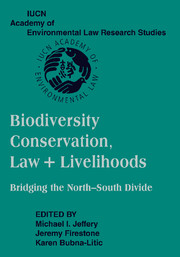 Biodiversity Conservation, Law and Livelihoods: Bridging the North-South Divide
Biodiversity Conservation, Law and Livelihoods: Bridging the North-South Divide Published online by Cambridge University Press: 31 July 2009
INTRODUCTION
Climate change driven by global warming is threatening to substantially modify important ecosystems, both marine and terrestrial, because the rate of climate change exceeds rates at which ecosystems and the biodiversity they contain can adapt or migrate. Global warming threatens to destroy great swaths of biodiversity within affected ecosystems. Preservation of biodiversity and avoidance of catastrophic ecosystem collapse depend on global success in reducing emissions of greenhouse gases and stabilizing (or, hopefully, reducing) atmospheric green house gas concentrations. For lawyers, the challenge is how law can be used to achieve this goal.
Two separate sets of laws exist – laws concerning biodiversity and endangered species (e.g., the United Nations Convention on Biological Diversity [CBD], and the U.S. Endangered Species Act [ESA] and comparable laws in other countries) and emerging laws addressing greenhouse gas emissions. Both bodies of law mirror the same analytic questions. That is, to what extent do national and international biodiversity laws consider climate change in their regulatory frameworks? And, to what extent does the emerging climate change legal regime consider biodiversity in its regulatory schemes? Is the extent of incorporation adequate and effective? If not, how could laws be improved to incorporate biodiversity concerns into climate change decisions, and to fold climate change concerns into the operation of biodiversity laws?
To save this book to your Kindle, first ensure [email protected] is added to your Approved Personal Document E-mail List under your Personal Document Settings on the Manage Your Content and Devices page of your Amazon account. Then enter the ‘name’ part of your Kindle email address below. Find out more about saving to your Kindle.
Note you can select to save to either the @free.kindle.com or @kindle.com variations. ‘@free.kindle.com’ emails are free but can only be saved to your device when it is connected to wi-fi. ‘@kindle.com’ emails can be delivered even when you are not connected to wi-fi, but note that service fees apply.
Find out more about the Kindle Personal Document Service.
To save content items to your account, please confirm that you agree to abide by our usage policies. If this is the first time you use this feature, you will be asked to authorise Cambridge Core to connect with your account. Find out more about saving content to Dropbox.
To save content items to your account, please confirm that you agree to abide by our usage policies. If this is the first time you use this feature, you will be asked to authorise Cambridge Core to connect with your account. Find out more about saving content to Google Drive.